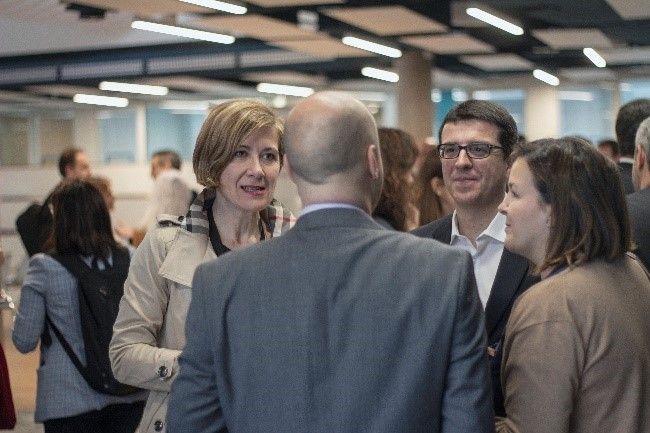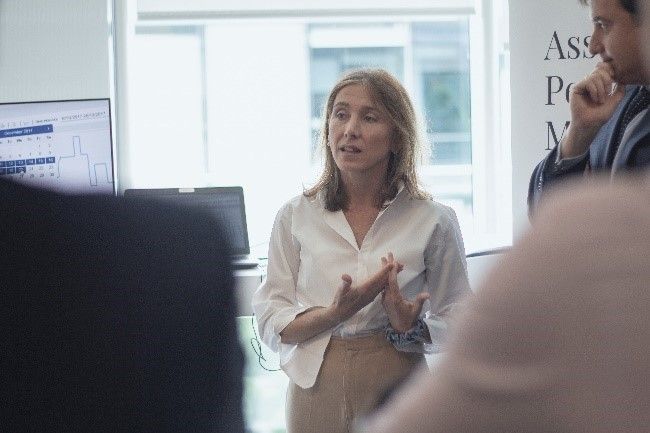
The future of cognitive technologies for the energy sector
The purpose of the conference was to disseminate and present how Artificial Intelligence and Advanced Analytics can help companies optimize their business processes and reduce costs in a series of talks and specific use cases.
On May 8, 2019, the Energy market organized the workshop “The future of cognitive technologies for the energy sector” in the Agora Room of the InWork space, in our Arroyo de la Vega facilities.

The workshop was attended by important Technology Partners of the market: Microsoft and Intel; who announced to all attendees their views on Artificial Intelligence and the application of cognitive technologies in the sector in different talks.
Many market customers attended the event, with the presence of over 50 people representing companies in the energy sector, such as Endesa, Red Eléctrica de España, Repsol, Iberdrola, Naturgy, EDP and AXPO, among others.
The day, moderated by Javier Pascual, professional of the Energy market, and Maria Fernanda Fernandez, of Tecnologías Avanzas, was divided into 4 general talks and the presentation of 5 specific use cases:
- In the first talk, Leonardo Benítez, Managing Director of Energy & Utilities at Minsait, opened the conference explaining the transformation that is taking place in the Utilities sector, associated with new emerging technologies in the sector and how this affects the entire value chain.
- In the second talk, José Luis Flórez Fernandez, Director of Artificial Intelligence and Advanced Analytics at Minsait, analyzed how to extract the potential of cognitive technologies in a very didactic manner, driving businesses through them.
- In the next block, two of our most important technology partners in the energy market (Intel and Microsoft) delighted us with their views on Artificial Intelligence. Jorge Lang, Innovation & Partners, Director of Intel, followed by Juan Carlos Rodriguez García, Cloud Solution Architect – Data from Microsoft. Both talks showed us how these companies are collaborating with Minsait to help energy companies.
After these talks, there was a short coffee break to share opinions and experiences with our customers. The next talk was on use cases:

- The first one focused on the use of artificial vision to assist in infrastructure management and maintenance. Javier Torres, Head of the Artificial Vision line at Minsait, gave us a demo in which different Artificial Vision recognition models were applied using a small drone that flew in one of our meeting rooms. He also discussed how objects, places and people can be recognized in a hydroelectric plant, improving workflows and preventing accidents. Next, Andrés Sánchez-Biezma Sacristan, Head of the Thermal Innovation area of ENDESA Generación in Spain and Portugal, explained the joint project undertaken between Endesa and Minsait to apply artificial vision techniques for the surveillance of thermal power plants. Thermal and discharge control procedures are performed at the plant using cameras and algorithms.All other use cases were presented in a corner event, making them more agile and so the customers could approach those that were of interest to them. Our experts told them firsthand the real experiences we have developed with Energy customers:
- Smart asset management. Silvia Lusarreta, Head of the Monitoring and Predictive Analysis area of the Minsait Energy Market, explained the characteristics and benefits provided by our Onesait Plants APM (Asset Performance Management) solution for comprehensive and on-going monitoring of assets; this enables the optimization of their reliability and efficiency, while reducing operating and maintenance costs.
- Use of optical fiber in leak detection tasks. Estrella Jara, Head of the Oil and Gas product area in the Energy market, explained the Onesait O&G sensoring solution, an automatic system for detecting leaks and threats in pipelines in real time, based on Sensorization and interpretation of data gathered through fiber optics. The System uses algorithms based on artificial intelligence to convert optical signals into alarms, for their subsequent management and processing in an intuitive and functional user interface.

- Reputational Risk. Fatima Galan discussed how textual techniques have proven to be decisive in anticipating the risks associated with your company or analyzing competition.
- Cognitive customer analysis. María Fernández Baña, Head of the Minsait Artificial Intelligence Unit for the Energy and Utilities sector, explained how to measure the economic impact of customer satisfaction.
We consider that this was a very positive and enriching experience according to the number of people attending the event and the presence of the company’s workers. This experience has allowed us to disseminate the initiatives that are being undertaken in projects within the company and with the added value of creating positive synergies with customers.
